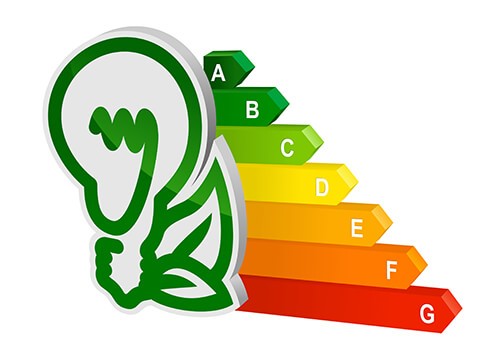
An air conditioner is often one of the biggest users of electricity in the home, so it is a good idea to carefully consider the amount of power your unit will need. Different types of units will vary significantly on their wattage, so your air conditioner might end up using anywhere from 500 to 4,000 watts each hour. If you want to save energy, here are some important things you need to know.
What Is an Air Conditioner’s Wattage?
Most people are aware that a watt is somehow related to electricity and power. A greater number of watts means an item uses more energy to run. However, the average person’s understanding of watts tends to be a little on the abstract side. To truly understand what it means to have a 3,000-watt or a 500-watt air conditioner, it is helpful to know what a watt really is.
The watt is the standard unit for measuring how much power something uses. One watt describes the rate at which work is done when a single ampere of current flows. Essentially, when people talk about wattage, they are discussing the rate at which power has to flow to the air conditioner to make it run at any given time. The wattage of an air conditioner refers to the watts it uses for an hour of run time.
Of course, an air conditioner needs far more than a single watt of power to actually run, so they often have ratings like 1,500 watts. This would mean that the air conditioner uses 1,500 watts of power over the course of an hour. These numbers are large and somewhat awkward, so equipment is rated in kilowatts. A kilowatt is 1000 watts of power. So, if an AC unit is rated at 1.5 kilowatt hours, that means it uses 1,500 watts of power over the course of an hour. These kilowatt hours are typically the measurement your power company uses to calculate your electric bill.
What’s the Average Wattage of an Air Conditioner?
There is no standard wattage for air conditioners because all models tend to be quite different. You can get a basic estimate of how many watts a unit uses by considering its size. Small air conditioning units meant for individual rooms might have a wattage of around 500 to 1,400. If you have a central air conditioning unit for a small home, expect to use around 1,100 watts to 1,900 watts. Central air conditioning units of medium size may use somewhere between 1,500 and 2,900 watts. If you have a truly massive air conditioner for a large home, you might end up using somewhere between 2,500 and 4,800 watts.
Keep in mind that these numbers are rough estimates and that they average all the different run stages of an air conditioner. In the first few seconds when your air conditioner is starting up, it will draw power at a much faster rate. Meanwhile, if your air conditioner is only running the fan instead of actively cooling, its wattage will be much less. Just running the central air conditioning fan will take around 750 watts.
Factors That Affect How Many Watts an AC Uses
Why is there so much variation in wattage among different AC units? There are several factors that can affect a machine’s efficiency. It all comes down to the way a unit is made. Some of the most important considerations are the sizes of the evaporator and condenser coils. Larger ones provide a greater area of heat transfer surfaces so they can cool air more rapidly.
Another way that air conditioning manufacturers reduce wattage is by using special motors. Newer electric motors tend to be very efficient. Though they cost a little more to install, they can provide savings because they require less power to get your air conditioner’s fan moving and its compressor running. Even little things like the types of materials used for the outside of the case can have a big impact on overall wattage.
How to Tell the Wattage of Your Air Conditioner
Ultimately, there are all sorts of factors that can affect how much power your air conditioner uses. To figure out the wattage of your specific model, you will need to look carefully at your unit. Many air conditioner manuals or manufacturer’s guides will tell you the wattage for your air conditioning equipment. If you do not have this information, check the sticker label that will be somewhere on your AC unit.
Some labels will include wattage, but even if they do not, you can still calculate it. All you have to do is look for the voltage and the amperage. These are facts that AC companies are required to include on the label. You can multiply these two numbers together to get the watts your air conditioner uses. If you want to calculate your electric bill, you can just divide this number by 1,000 to get the kilowatt hours used by your air conditioner.
How to Save Energy When Running Your AC
If you do not like the number of watts your air conditioner is using, you have several options.
1. Switch From Incandescent Light Bulbs to Cooler Led Bulbs
Incandescent bulbs produce a lot of heat, which can cause your AC unit to work overtime. On the other hand, LED bulbs produce very little heat, making them a much more efficient option for summertime lighting. In addition to being more energy efficient, LED bulbs also last longer than incandescent bulbs, so you won’t have to worry about replacing them as often. So, if you’re looking for ways to stay cool this summer, switching to LED light bulbs is a great place to start.
2. Make Sure That Your AC Unit Is Properly Sized for Your Home
An AC unit that is too small will have to work harder to cool your home, while an AC unit that is too large will use more energy than necessary. Either way, you’ll end up paying more on your energy bill. The best way to ensure that your AC unit is the right size for your home is to have a professional HVAC contractor come out and do a load calculation.
3. Change Your AC Unit’s Air Filter
A dirty air filter can restrict airflow, causing your AC unit to work harder and use more energy. Change the air filter every month or two to keep your AC unit running smoothly and efficiently. Additionally, keep your AC unit clean and free of debris, trim back any foliage that might be blocking the unit, and remove any leaves or dirt that have collected on the coils. Most manufacturers recommend changing the air filter every three months.
4. Upgrade Your Insulation
If your home is poorly insulated, it’ll be harder to keep cool in the summer. By upgrading your insulation, you can keep cool air in and hot air out, making it easier for your AC unit to do its job. Upgrading your insulation is a big project, but it’s one that can pay for itself in energy savings over time.
5. Keep Curtains and Blinds Closed
During the day, sunlight can shine through windows, making your home warm. To help keep your home cool, be sure to keep curtains and blinds closed during the day. This will help block out the sun’s heat, making it easier for your AC unit to keep your home cool.
6. Refrain From Heat-Producing Activities
During the summer, avoid heat-producing activities like cooking and laundry. These activities can raise the temperature in your home, making it harder for your AC unit to cool things down. If possible, do these activities during the cooler hours of the day or evening.
7. Clear Your Drain Line
A clogged drain line can cause your AC unit to work harder than necessary, which in turn uses more energy and raises your utility bills. To keep your drain line clear, remove any leaves, dirt, or debris that might be blocking it. You can also pour a cup of chlorine bleach down the drain line and rinse it with some water to help clear it out.
8. Install a Ceiling Fan
A ceiling fan can help circulate cool air, making it easier for your AC unit to do its job. Additionally, a ceiling fan can help you feel cooler, so you can set your thermostat to a higher temperature and save on your energy bill. Ideally, an app on your phone can control a high-tech smart ceiling fan, so it will only run when needed.
9. Upgrade Your AC Unit
If your AC unit is more than a few years old, it may be time to consider an energy-efficient model. Newer AC units are designed to use less energy while still providing the same level of cooling power. This can help to lower your energy bills and reduce your carbon footprint. In addition, newer AC units often come with features that can make them even more energy efficient, such as programmable thermostats and energy-saving modes.
10. Unblock and Vacuum Your Vents
If your vents are blocked or dusty, they can restrict airflow and make it harder for your AC unit to cool your home. Vacuum your vents regularly to keep them clear and clean. You can also use a brush attachment on your vacuum cleaner to help remove any dust or debris blocking the vents.
11. Shade the Outside Condenser Unit
If your AC’s condenser unit is in the sun, it will have to work harder to cool your home. Shade the condenser unit by planting trees or shrubs around it or erecting a screen or fence. This will help keep the unit cool, so it doesn’t have to work as hard – and use as much energy – to cool your home.
13. Check the Refrigerant Level
If your AC unit is low on refrigerant, it’ll have to work harder to cool your home. Check the refrigerant level and have it topped off if necessary. This is a simple process that anyone can do, but it’s always best to consult a professional if you’re not sure. With a little care, you can keep your fridge running smoothly all summer and save money on your energy bill.
14. Get Your AC Unit Serviced Regularly
Like any other appliance, your AC unit needs regular maintenance to run efficiently. Furthermore, regular servicing can help pinpoint potential problems before they cause major damage. For example, a small leak in the refrigerant line may not seem like a big deal, but if left unchecked, it can lead to extensive damage and costly repairs. Have your AC unit serviced by a qualified technician at least once a year. This will help keep it running properly and use less energy.
15. Seal AC Ducts
A typical home’s air conditioning system has a furnace or heat pump that blows air through a network of ducts to cool the house. Cooled air can escape if these ducts are not properly sealed, leading to higher energy bills and an uncomfortable home. Sealing ductwork is a relatively simple and inexpensive way to improve the efficiency of your AC system, and a qualified HVAC technician can do it. Sealing your ductwork can also help to improve indoor air quality by preventing dust and other contaminants from entering your home.
16. Turn Off Your AC When You’re Not Home
Running your AC unit round-the-clock can put a serious strain on your energy bill. To reduce AC costs, turn off the unit when you’re not home. During the daytime, open the windows and let natural ventilation cool your home. Close the windows and draw the curtains at night to keep the cool air in.
17. Get a Programmable Thermostat
You can save as much as 10% a year on your cooling and heating bill by simply turning your thermostat back 7°-10° for eight hours a day from its normal setting. A programmable thermostat will allow you to automatically adjust the temperature when you are away or asleep.
If you are interested in saving energy, Polar Air & Heating, Inc. is here to help. We can service your machine to help it run more efficiently, or we can help you install a new, energy-efficient air conditioner. In fact, our team performs a complete range of cooling, heating and indoor air quality installations, maintenance and repairs throughout the Las Vegas region. Give us a call today to discuss your home comfort needs or schedule an appointment.




















